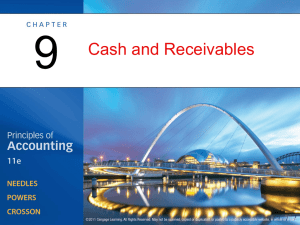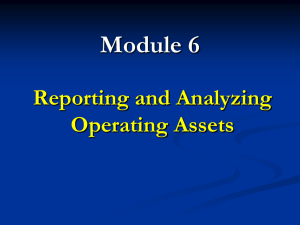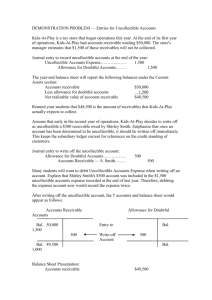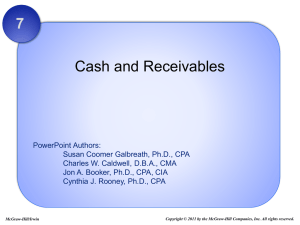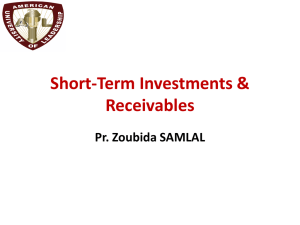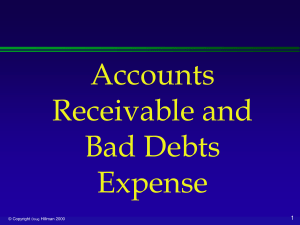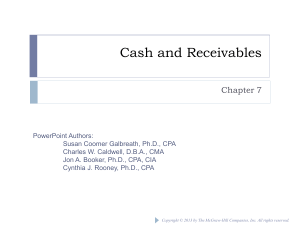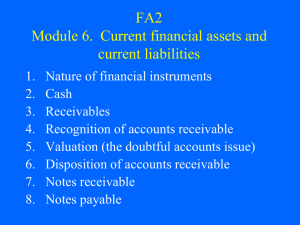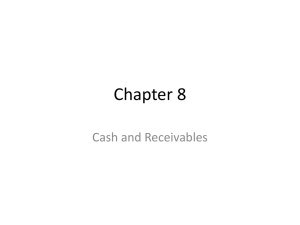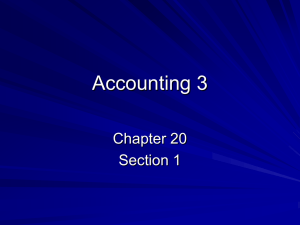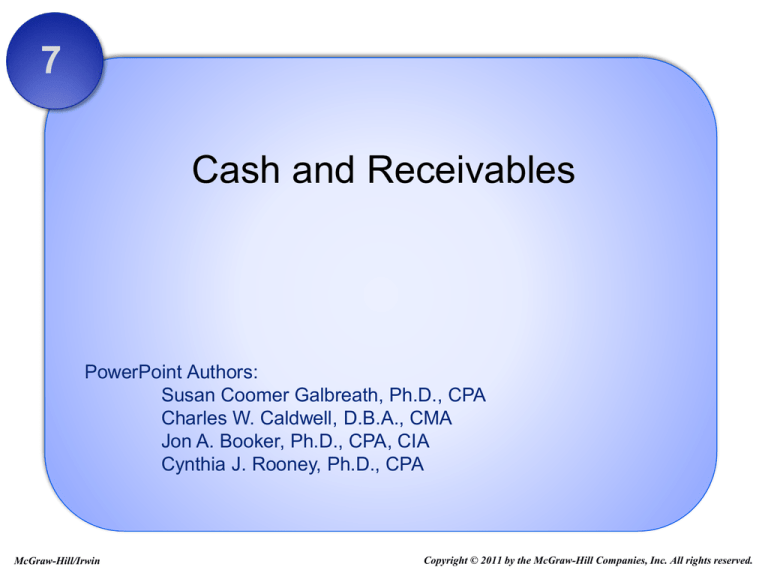
7
Cash and Receivables
PowerPoint Authors:
Susan Coomer Galbreath, Ph.D., CPA
Charles W. Caldwell, D.B.A., CMA
Jon A. Booker, Ph.D., CPA, CIA
Cynthia J. Rooney, Ph.D., CPA
McGraw-Hill/Irwin
Copyright © 2011 by the McGraw-Hill Companies, Inc. All rights reserved.
Cash and Cash Equivalents
Cash
Currency
and coins
Balances in
checking
accounts
Items for deposit such as
checks and money orders
from customers
Cash equivalents are short-term, highly liquid
investments that can be readily converted to cash.
Money market
funds
7-2
Treasury bills
Commercial
paper
Internal Control
Encourages adherence to
company policies
and procedures
Promotes operational
efficiency
Minimizes errors
and theft
Enhances the reliability and
accuracy of accounting data
7-3
Internal Control Procedures
Cash Receipts
• Separate responsibilities for receiving cash, recording
cash transactions, and reconciling cash balances.
• Match the amount of cash received with the amount of
cash deposited.
• Close supervision of cash-handling and cash-recording
activities.
Cash Disbursements
•
•
•
7-4
All disbursements, except petty cash, made by check.
Separate responsibilities for cash disbursement
documents, check authorization, check signing, and
record keeping.
Checks should be signed only by authorized
individuals.
Restricted Cash and
Compensating Balances
Restricted Cash
Management’s intent to use a certain amount
of cash for a specific purpose – future plant
expansion, future payment of debt.
Compensating Balance
Minimum balance that must be
maintained in a company’s bank
account as support for funds
borrowed from the bank.
7-5
U.S. GAAP vs. IFRS
In general, cash and cash equivalents are
treated similarly under IFRS and U.S. GAAP. One difference
is highlighted below.
• Bank overdrafts are treated as
liabilities.
7-6
• Bank overdrafts may be offset
against other cash accounts.
Accounts Receivable
Result from the credit
sales of goods or
services to customers.
Are classified as
current assets.
Are recorded net of
trade discounts.
7-7
Cash Discounts
increase sales
Cash discounts
encourage early
payment
increase likelihood of
collections
7-8
Cash Discounts
2/10,n/30
Discount
percent
7-9
Number of
days
discount is
available
Otherwise,
net (or all)
is due
Credit
period
Cash Discounts
Gross
Method
Net
Method
Sales are recorded
at the invoice
amounts.
Sales are recorded at
the invoice amount
less the discount.
Sales discounts
are recorded as reduction
of revenue if payment is
received within the
discount period.
7 - 10
Sales discounts forfeited
are recorded
as interest revenue if
payment is received after
the discount period.
Cash Discounts
On October 5, Hawthorne sold merchandise for $20,000 with terms
2/10, n/30. On October 14, the customer sent a check for $13,720
taking advantage of the discount to settle $14,000 of the amount.
On November 4, the customer paid the remaining $6,000.
7 - 11
Sales Returns
Merchandise
may be
returned by
a customer
to a supplier.
A special price
reduction, called
an allowance,
may be given as
an incentive to
keep the
merchandise.
To avoid misstating the financial statements,
sales revenue and accounts receivable
should be reduced by the amount of returns
in the period of sale if the amount of returns
is anticipated to be material.
7 - 12
Sales Returns
During the first year of operations, Hawthorne sold $2,000,000
of merchandise that had cost them $1,200,000 (60%). Industry
experience indicates 10% return rate. During the year
$130,000 was returned prior to customer payment. Record the
returns and the end of the year adjustment.
Actual Returns
Sales returns
Accounts receivable
Inventory
Cost of goods sold (60%)
Adjusting Entries
Sales returns
Allowance for sales returns
Inventory-estimated returns
Cost of goods sold (60%)
7 - 13
130,000
130,000
78,000
78,000
70,000
70,000
42,000
42,000
Uncollectible Accounts Receivable
Bad debts result from credit customers who are
unable to pay the amount they owe,
regardless of continuing collection efforts.
In conformity with the matching
principle, bad debt expense
should be recorded in the same
accounting period in which the
sales related to the uncollectible
account were recorded.
7 - 14
PAST DUE
Uncollectible Accounts Receivable
Most businesses record an estimate of the
bad debt expense by an adjusting entry
at the end of the accounting period.
Normally classified as
a selling expense and
closed at year-end.
Contra asset account to
Accounts Receivable.
Bad debt expense
Allowance for uncollectible accounts
7 - 15
xxx
xxx
Allowance for Uncollectible Accounts
Accounts Receivable
Less: Allowance for Uncollectible Accounts
Net Realizable Value
Net realizable value is the amount of the accounts
receivable that the business expects to collect.
Income Statement Approach
Balance Sheet Approach
◦ Composite Rate
◦ Aging of Receivables
7 - 16
Income Statement Approach
• Focuses on past credit sales to make
estimate of bad debt expense.
• Emphasizes the matching principle by
estimating the bad debt expense associated
with the current period’s credit sales.
Bad debt expense is computed as follows:
Current Period Credit Sales
× Estimated Bad Debt %
= Estimated Bad Debt Expense
7 - 17
Income Statement Approach
In 2012, MusicLand has credit sales of $400,000 and
estimates that 0.6% of credit sales are uncollectible.
What is Bad Debt Expense for 2012?
MusicLand computes
estimated Bad Debt
Expense of $2,400.
$
×
= $
400,000
0.60%
2,400
Bad debt expense
Allowance for uncollectible accounts
7 - 18
2,400
2,400
Balance Sheet Approach
• Focuses on the collectability of accounts receivable
to make the estimate of uncollectible accounts.
• Involves the direct computation of the desired
balance in the allowance for uncollectible accounts.
Compute the desired balance in the Allowance for
Uncollectible Accounts.
Bad Debt Expense is computed as:
Desired Balance in Allowance for
Uncollectible Accounts
Existing Year-End Balance in Allowance for
Uncollectible Accounts
= Estimated Bad Debt Expense
7 - 19
Balance Sheet Approach
Composite Rate
On Dec. 31, 2012, MusicLand
has $50,000 in Accounts
Receivable and a $200 credit
balance in Allowance for
Uncollectible Accounts.
Past experience suggests that
5% of receivables are
uncollectible.
What is MusicLand’s Bad Debt
Expense for 2012?
7 - 20
Balance Sheet Approach
Composite Rate
Desired balance in Allowance
for Uncollectible Accounts
$
×
= $
50,000
5.00%
2,500
Allowance for
Uncollectible
Accounts
200
Bad debt expense
Allowance for uncollectible accounts
7 - 21
2,300
2,500
2,300
2,300
Balance Sheet Approach
Aging of Receivables
Year-end Accounts Receivable is broken down
into age classifications.
Each age grouping has a different likelihood
of being uncollectible.
Compute desired uncollectible amount.
Compare desired uncollectible amount with
the existing balance in the
allowance account.
7 - 22
Balance Sheet Approach
Aging of Receivables
At December 31, 2012, the receivables for
EastCo, Inc. were categorized as follows:
EastCo, Inc.
Schedule of Accounts Receivable by Age
Days Past Due
Current
1 - 30
31 - 60
Over 60
December 31, 2012
Accounts
Estimated
Receivable
Percent
Balance
Uncollectible
$
$
7 - 23
45,000
15,000
5,000
2,000
67,000
Estimated
Allowance
1% $
3%
5%
10%
$
450
450
250
200
1,350
Balance Sheet Approach
Aging of Receivables
• EastCo’s unadjusted balance
in the allowance account is
$500.
Allowance for
Uncollectible
Accounts
500
• Per the previous computation,
the desired balance is $1,350.
Bad debt expense
Allowance for uncollectible accounts
7 - 24
850
1,350
850
850
Uncollectible Accounts
As accounts become uncollectible, this entry is made:
Allowance for uncollectible accounts
Accounts receivable
500
500
When a customer makes a payment after an account has
been written off, two journal entries are required.
Accounts receivable
Allowance for uncollectible accounts
500
Cash
500
Accounts receivable
7 - 25
500
500
Direct Write-off Method
If uncollectible accounts are immaterial, bad
debts are simply recorded as they occur
(without the use of an allowance account).
Bad debts expense
Accounts receivable
7 - 26
xxx
xxx
Notes Receivable
A written promise to pay a specific
amount at a specific future date.
Face
amount
of the
note
×
Annual
interest
rate
Even for
maturities less
than 1 year, the
rate is
annualized.
7 - 27
×
Fraction of
the annual =
period
Interest
Interest-Bearing Notes
On November 1, 2012, West, Inc. loans $25,000 to Winn Co. The
note bears interest at 12% and is due on November 1, 2013.
Prepare the journal entry on November 1, 2012, December 31,
2012, (year-end) and November 1, 2013 for West.
November 1, 2012
Notes receivable
Cash
December 31, 2012
Interest receivable
Interest revenue
November 1, 2013
Cash
Note receivable
Interest receivable
Interest revenue
7 - 28
25,000
25,000
500
500
28,000
25,000
500
2,500
Noninterest-Bearing Notes
Actually do bear interest.
Interest is deducted
(discounted) from the face
value of the note.
Cash proceeds equal face
value of note less discount.
7 - 29
Noninterest-Bearing Notes
On Jan. 1, 2012, West, Inc. accepted a $25,000 noninterestbearing note from Winn, Co as payment for a sale. The note
is discounted at 12% and is due on Dec. 31, 2012.
Prepare the journal entries on Jan. 1, 2012, and Dec. 31, 2012.
January 1, 2012
Notes receivable
Discount on notes receivable
Sales revenue
($25,000 * 12% = $3,000)
December 31, 2012
Cash
Discount on notes receivable
Interest revenue
Note receivable
7 - 30
25,000
3,000
22,000
25,000
3,000
3,000
25,000
U.S. GAAP vs. IFRS
In general, IFRS and U.S. GAAP are very similar with respect
to accounts receivable and notes receivable. Differences are
highlighted below.
• U.S. GAAP allows a “fair value
option” for accounting for
receivables.
• U.S. GAAP does not allow
receivables to be accounted
for as “available for sale”
investments.
• U.S. GAAP requires more
disaggregation of accounts
and notes receivable in the
balance sheet or notes.
7 - 31
• IFRS restricts the
circumstances in which a “fair
value option” for accounting for
receivables is allowed.
• In the years between 2010 and
2012, companies may account
for receivables as “available
for sale” investments if the
approach is elected initially.
After January 1, 2013, this
treatment is no longer allowed.
Financing With Receivables
Companies may use their
receivables to obtain
immediate cash.
7 - 32
Factoring Arrangements
2. Accounts Receivable
SUPPLIER
(Transferor)
RETAILER
1. Merchandise
FACTOR
(Transferee)
A factor is a financial institution that buys receivables
for cash, handles the billing and collection of the
receivables and charges a fee for the service.
7 - 33
Sale of Receivables
Treat as a sale if all of these conditions are met:
receivables are isolated from transferor.
transferee has right to pledge or exchange
receivables.
transferor does not have control over the
receivables.
Transferor cannot repurchase
receivable before maturity.
Transferor cannot require return
of specific receivables.
7 - 34
Sale of Receivables
Without recourse
•
•
•
•
An ordinary sale of receivables to the factor.
Factor assumes all risk of uncollectibility.
Control of receivable passes to the factor.
Receivables are removed from the books, fair value of
cash and other assets received is recorded, and a
financing expense or loss is recognized.
With recourse
• Transferor (seller) retains risk of uncollectibility.
• If the transaction fails to meet the three conditions
necessary to be classified as a sale, it will be treated as
a secured borrowing.
7 - 35



